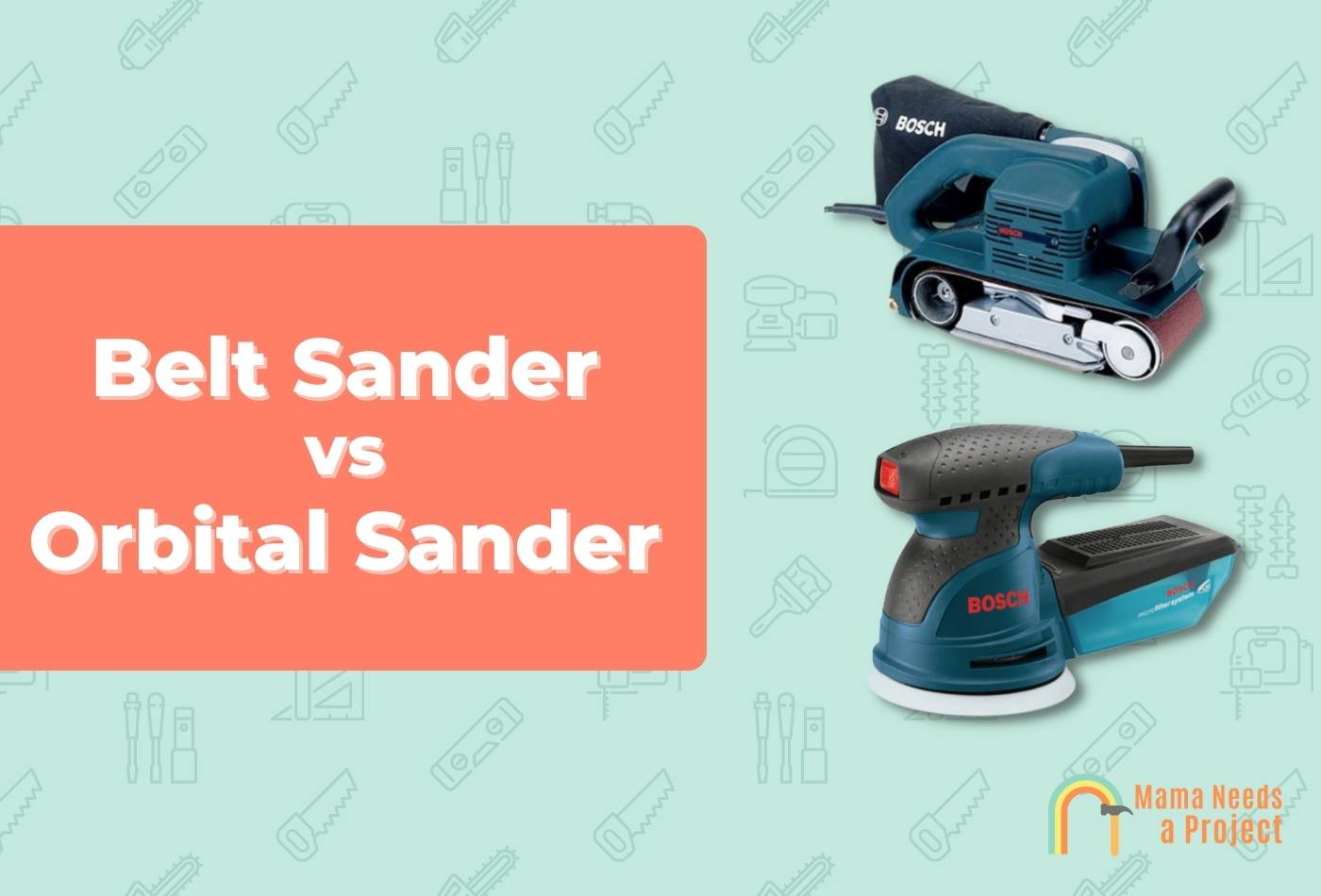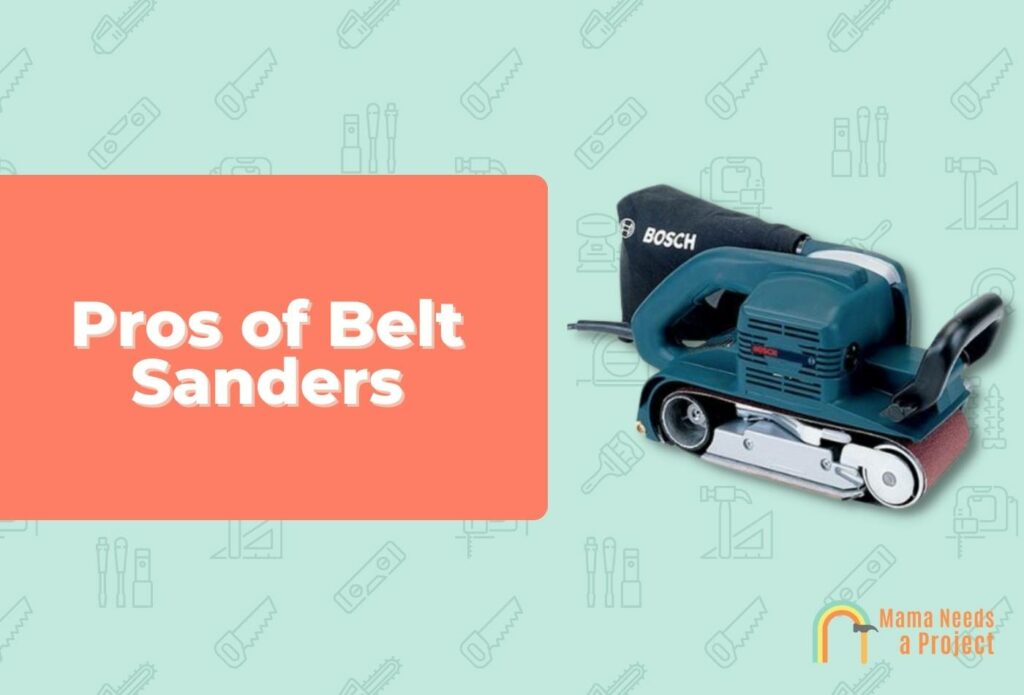Belt Sander vs Orbital Sander: Key Differences & Which to Use (2024 Guide)
Wether you’re working on your next woodworking project or you’re starting a DIY project, there’s a strong chance some sanding will be involved at some point.
But when it comes to sanding, you have options. There are several power tools that can make your job easier.
Two of the most popular sander types include power belt sanders or an orbital sander.
In this post, I’ll take a look at a belt sander vs orbital sander, which one you should use for your project, and much more. Let’s get started!
Size
Generally speaking, orbital sanders and portable belt sanders are physically similar in size. But when it comes to sanders, “size” often refers to how big the sandpaper disc or belt is.
A belt sander that’s designed for small tasks, for example, will have a belt that’s just a few inches wide and about a foot long, whereas a larger belt sander that’s designed to handle heavy-duty materials will have a belt that’s between 4” and 5” in width and over 2’ in length. Most home shops include a belt sander that’s 3” x 21”.
An orbital sander, on the other hand, will have sanding discs that are about 5 inches in diameter.
Of course some orbital sanders have a larger disc whereas others have a smaller one. Since orbital sanders are mainly used for tasks that require precision sanding, the small-disc tools are more common than those which utilize a larger disc.
The stationary belt sander can be either large or small; some can be used on a table while others have legs and can be as tall as 4 feet.
There’s no such thing as a “stationary orbital sander”, simply because this sander wouldn’t be able to sand as it does if it were stationary.
Power
When it comes to power, the belt sander is the more powerful of these two tools.
But just because it’s more powerful than the orbital sander doesn’t mean the orbital sander isn’t powerful.
In truth, the belt sander is great at certain jobs, while the orbital sander is great at others, and the power each tool possesses in large part determines what tasks it can complete efficiently.
If, for example, you have to sand a piece of wood thoroughly yet quickly, the belt sander should be the tool you reach for. One thing to keep in mind when using the belt sander—as far as power is concerned—is that you have to be careful and precise when using it. Because it’s so powerful, there’s little room for correction once you put it to the wood’s surface.
The orbital sander, on the other hand, is great for sanding corners, edges, stairs, and small surfaces. You can find orbital sanders that have decent torque and high amp ratings, so don’t think these tools are inherently weak.
In the end, if you need to sand a large surface quickly, the belt sander’s power makes this tool the ideal one for the job. But if it’s furniture or stairs that need a smooth surface, choose a powerful and precise orbital sander.
You can also check out this orbital sander vs palm sander comparison for more help deciding which type of sander is best for your project!
Speed
Before comparing belt and orbital sanders in terms of speed, you need to know that belt sander speed isn’t measured like how orbital sander speed is measured.
Specifically, the metric used to gauge the speed of an orbital sander is “orbits per minute”, whereas the speed of a belt sander is measured in “feet per minute”.
Since these tools don’t measure speed the same way, sometimes comparing these tools in terms of speed can be difficult. And when you’re considering speed, you need to consider power as well, since the speed at which a sander can sand is inextricably linked to how strong it is.
That said, a belt sander should be used on heavy-duty materials (hardwood flooring) because of its speed and power, whereas a fast but less powerful orbital sander should be used on furniture. If you try to sand a large, heavy-duty surface with an orbital sander, you run the risk of overheating and even damaging the tool.
Usability
Both the belt sander and the orbital sander are pretty easy to use.
Orbital sanders aren’t hard to handle in large part because they come with a comfortable grip. And if you have a task that requires precision sanding, you can use either a jug-grip or a pistol-grip orbital sander, both of which are perfect for such tasks.
You can find both a stationary and handheld belt sander, and while some believe one kind of sander is easier to use, others believe the opposite.
In truth, both systems become easy to use once you’ve been working with them for awhile, but someone who’s never worked with either would probably have an easier time getting the hang of a handheld belt sander first.
That said, even though portable belt sanders are smaller than their stationary cousins, they still pack a punch, which means using one may still be physically demanding.
The stationary belt sander, on the other hand, won’t drain your energy; all you have to do is push the wood (or another material) through the sander. In some cases, all you need is a little bit of finger strength to get a surface sanded.
In short, you’ll need to apply a bit of pressure when using either an orbital sander or a portable belt sander, but generally speaking both tools are easy to use, as they handle well and rarely act erratically.
If you’re looking for a cordless sander, check out my list of the best cordless sanders for your money!
Precision
The level of precision a tool can deliver is collectively determined by its size, power, speed, and usability. When it comes to precision, both the belt sander and the orbital sander can be precise. However, in order for either sander to be precise, the application has to be right.
In other words, you can’t use a belt sander for a job that requires light sanding and expect amazing precision. Similarly, you can’t expect an orbital sander to be all that precise when the surface you’re sanding is large.
Some say the belt sander is best when you need to sand quickly, deeply, and imprecisely, but that doesn’t mean the belt sander can’t deliver precise results if you take your time. For example, if you can sand with the woodgrain, you’ll have an easier time sanding out imperfections.
An orbital sander has a harder time sanding with woodgrain because of how it operates, but it can be great when you need to lightly sand cabinets, stairs, or furniture legs at an angle. If you were to use a belt sander for any of these jobs, it’s likely you’d take off too much of the surface.
Dust
Sanding almost always results in a lot of dust being created, so how a sander handles dust accumulation is important.
Both a belt sander and orbital sander handle dust collection similarly, but the components these tools utilize to handle dust collection are often different. Both sanders are outfitted with dust-collection and dust-removal systems to ensure clean, safe, and efficient sanding.
Specifically, some sanders utilize a vacuum, whereas others come with a dust-collection bag. And both belt sanders and orbital sanders have filters to keep the dust away from important inner components.
The stand-up belt sander doesn’t utilize the dust-collection components that a portable belt sander does, but it’s just as efficient at removing dust. Plus, you can remove any leftover dust from a stand-up belt sander by hand—once you’ve ensured it’s safe to do so.
When to Use a Belt Sander
There are a variety of sanding tasks that call for a belt sander over an orbital sander. And sometimes, a task may require a stand-up belt sander instead of a portable one. Below are some of the common sanding tasks that call for a belt sander:
Installing or Repairing Hardwood Floors
If you’re refinishing hardwood floors that have been accustomed to heavy traffic for years, a power sander is going to be a vital tool. In this instance, you’ll sand down the floors before refinishing the wood, and how effective the sander is will determine how the finished product comes out.
Sanding Large, Flat Surfaces
The belt sander is ideal for sanding any large, flat surfaces because it can cover a lot of area quickly and eliminate all kinds of defects with its power. And if you have a stand-up belt sander that can accommodate a large surface, you’ll get a more precise finish than you would if you used a portable belt sander.
Sanding Metal
A belt sander is strong enough to sand metal. However, you’ll need to follow specific directions when doing so to ensure you sand properly and safely.
Sanding a Rigid Surface Quickly
Some surfaces are rigid, and if you want to deeply sand such a surface quickly, the belt sander can do just that. If leveling rough surfaces is your goal, go with a belt sander.
When Power Is Required Over Precision
One of the reasons why the belt sander is fantastic is because it delivers high power at a high speed, though this is usually at the cost of precision. But not all sanding jobs require a precise sanding, and in situations where precision isn’t a must, a belt sander can perform well.
Pros of Belt Sanders
By now, it should be clear that the belt sander is a versatile tool that’s ideal for a variety of sanding tasks. But to make things easier to grasp, here are some of the pros of using power belt sanders.
Versatility: Since you can swap out belts quickly and easily, you have more control over what kind of finish the sander delivers. Plus, since there are numerous belts out there, some of which are more abrasive than others, a belt sander can effectively and efficiently sand a variety of surfaces.
Avoid Overloading & Overheating: A belt sander that has a large, abrasive belt will not be as prone to overloading or overheating. In other words, a belt sander can run for a long time before a rest is required.
Scratches Created Can Be Removed Easily: Scratches left by a belt sander will be long but shallow, which means they can be easily covered up or removed. In fact, you can use an orbital sander to remove these scratches.
Utilizing a Platen: A belt sander has a platen, and this will make the finished product easier to sand (with a smaller sander). The platen will also help the surface retain stain or paint.
Strength & Speed: Belt sanders are stronger and faster than other kinds of sanders, which means they’re ideal for tasks that require a quick, imprecise sanding.
Here’s how to use a belt sander.
Cons of Belt Sanders
Even though a belt sander provides numerous benefits, it—like all other tools—isn’t perfect. Therefore, the cons associated with this tool should be addressed as well:
Price: One factor that certainly distinguishes orbital sanders from belt sanders is price. Stand-up belt sanders, for example, cost much more than orbital sanders, in large part because stand-up belt sanders utilize more components.
But if you compare a portable belt sander to an orbital sander, you’ll see that there isn’t much difference in terms of price. The price of either tool is typically determined by brand, model, demand, and a variety of other factors.
Maintenance: Both stand-up and portable belt sanders are more difficult to maintain because of the components they utilize. Stand-up belt sanders specifically require more maintenance, but if you follow a proven maintenance schedule this tool could be reliable and efficient for over a decade.
More Dust Collection Required: Because these tools are powerful and fast, they create more dust when sanding. Therefore, a larger dust-collection system or dust-removal system is required. In either case, the component can make the belt sander more cumbersome.
When to Use an Orbital Sander
An orbital sander will be perfect for the following jobs.
Sanding Small Surfaces
An orbital sander handles small surfaces better than a belt sander, because of it’s smaller size and form factor.
Sanding Angles
Sanding at an angle is easier with a orbital sander. That said, you can do this with a belt sander, but you may not achieve the results you’d get with an orbital sander.
Sanding Corners & Edges
Sanding corners and rounding edges is one area where the orbital sander is particularly useful. You can even sand the majority of a surface with a belt sander and then leave the corners and edges for the orbital sander; this way you ensure a surface that’s smooth all the way around.
When Precision Is a Priority
If precision is what you’re after, choosing an orbital sander over a belt sander is your best bet. That said, if the surface is large, the belt sander can be just as precise. The orbital sander’s ability to be precise is mainly why it’s used to sand furniture old and new.
Pros of Orbital Sanders
Cost: Orbital sanders are usually less than belt sanders. The word “usually” is used here because you could find a used belt sander that’s cheaper than a new orbital sander. Orbital sanders being less expensive is a main reason why many DIYers have an orbital sander but no belt sander.
Versatility: Versatility is another quality that makes the orbital sander a widely used tool. This quality is also what makes it a go-to for DIYers both new and experienced.
Most DIYers only have to handle small sanding tasks around the house, and for such tasks the orbital sander is ideal. Whether you need to sand furniture or a few stairs, an orbital sander will do just fine.
Precision: An orbital sander’s ability to be precise is arguably its most attractive feature. If you want to get a surface as smooth as possible, you’ll need an orbital sander to handle the edges and corners.
One thing to keep in mind, however, is that an orbital sander will leave marks, so it’s best to go over the surface with sandpaper—after using the orbital sander—before staining or painting.
Here’s how to use an orbital sander.
Cons of Orbital Sanders
The cons associated with an orbital sander may prevent you from using this sander for a particular task.
Less Strength: Since an orbital sander isn’t as strong as a belt sander, it won’t effectively sand heavy-duty surfaces like a belt sander will. It’s not accurate to call the orbital sander “weak”, but it technically is when compared to the belt sander. That said, you may find that an orbital sander is powerful enough to accomplish the tasks you have.
Easier to Overload or Overheat: Because you need to run the tool for longer, it’s more prone to overloading and overheating. Therefore, you should be aware of how long the tool has been running when using it; you may need to let it rest multiple times before the task is complete.
Not as Fast: An orbital sander isn’t as fast as a belt sander, which means reaching a finished product with this sander may take longer. That said, if it takes longer to achieve high-quality results, you may not mind taking more time.
Potential for Swirl Marks: During the sanding process, an orbital sander can leave swirl marks that will need to be covered up once your job is done.
Final Thoughts on Belt Sander vs Orbital Sander
When determining between a belt sander vs orbital sander, there are some major differences between the two.
Both wood sanders will beat out hand sanding just about every time.
The main difference is all about the accuracy and precision you need.
If you’re sanding large and flat surfaces that don’t require extreme accuracy – go with a belt sander.
If you’re working with smaller projects like sanding furniture or working on detailed trim work – go with an orbital sander.
The choice really is all about what you need to get the job done.



